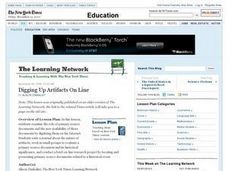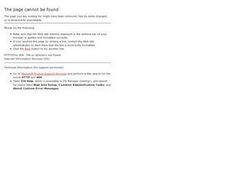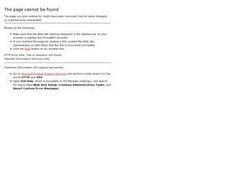Curated OER
Digging Up Artifacts On Line
Why is it important to preserve historical documents and artifacts? Examine the role of primary source documents and the availability of these documents on the Internet. Middle and high schoolers write a journal about the nature of...
Curated OER
Teaching With Documents: U.S. Constitution Workshop
What does it mean to be American? Explore the constitution and what it really means to be a citizen here. First, learners of all ages will investigate different primary source documents. Then, they establish each document's...
Curated OER
The Dust Bowl
Use this presentation to discuss the causes and effects of The Dust Bowl, or to establish a historical context for the book, The Grapes of Wrath. Found here are images, eye-witness quotes, and some ideas as to the causes and effects of...
Curated OER
World War II
Almost every big city has a war memorial, and many have memorials specific to WWII. This is a preparatory lesson for learners going on a trip to visit a local war memorial site. They are introduced to WWII through a simple time line of...
Curated OER
Teacher Notes
Gathering information, distinguishing between arguments, preparing an oral presentation; these skills are fostered as 10th graders explore aspects of global trade and politics. They use the Internet to gather information about NATO, The...
Curated OER
Little House in the Census: Almanzo and Laura Ingalls Wilder
How would you use census data from 1880-1900? Here are a set of ways you can incorporate the book Little House on the Prairie and US census data from that time period. Learners will research the validity or the book based on factual...
Curated OER
Document Analysis Sheet
Sometimes all kids need is a little guided practice and then they can be on their way. They can use an analysis worksheet to help them analyze a primary or secondary source document. They answer several questions describing the type of...
Curated OER
A Primary Source Picture Book
Travel through Europe with ten-year-old Teddy Roosevelt in this writing activity, which uses the picture book My Tour of Europe: by Teddy Roosevelt, by Ellen Jackson. After reading the book, readers compare it to passages from The...
Curated OER
William Apess and the Mashpee "Revolt" of 1833
Prompt your class with the following question: What was the status of American Indians in Massachusetts during Jackson's presidency? To answer this question, class members will read a series of primary source documents (attached),...
Curated OER
Finding James Fort
Welcome to Jamestown! Third and fourth graders read and analyze primary source documents about Jamestown or Fort James. They read and analyze descriptions of Fort James from primary sources. They access a website to explore more...
Curated OER
Reading Primary Source Documents: Historical Content
Why do we read primary source documents? What can they give us that other writings cannot? Provide your learners with any of the primary sources attached here (there are seven), and have them complete the graphic organizer (which opens...
Curated OER
Invetories Slave owner or not?
Primary source analysis is a great way to bring history to life. Learners examine a series of personal inventories taken from Southern white males who died during the Civil War era. They analyze the documents to determine the social and...
Curated OER
Colonial New York Slave Codes: Pedro's Walk
Look critically at the slave laws instated in Colonial New York. Your class examines primary source documents, slave laws, a narrative account from a slave's perspective, and Slave Codes. They write diary or journal entries in response...
Curated OER
Rights and the Wyandotte Constitution
Every state uses a set of rights to establish laws and regulations. Explore the Wyandotte Constitution as it was written in 1859 and compare it with how rights in Kansas have changed, especially those that pertain to gender and race. A...
Curated OER
Chaucer's Wife of Bath
A thorough and well-designed resource for older young scholars, this lesson focuses on Chaucer's character the Wife of Bath from his classic novel, The Canterbury Tales. As a way of understanding Chaucer's complex characterization and...
Curated OER
Henry VII - How Did Henry VII Get Up In the Morning?
Examine the daily life of Henry VII. In this Henry VII lesson, learners answer questions about the life in Medieval times after looking at primary source documents which are translated into contemporary English.
Curated OER
How Were European Nations Capable of Dominating the African Continent?
Primary source documents provide a realistic context for pupils to explore. Included are 5 experts relating European ideals and methods for colonizing and controlling the African continent. Middle schoolers answer 4 critical-thinking...
Curated OER
Revolutionary Money
Examine paper money from the American revolution! Historians study the paper bills and discuss the history of money. How has money changed over the times? Activities are included.
Curated OER
Seeking a Fortune in 18th Century Maritime Boston
Study the Revolutionary War era practice of recruiting seamen to prey upon the British shipping industry, and discuss the impact this practice had on the Colonial war efforts. Learners read and interpret recruiting advertisements for...
Curated OER
The Declaration Versus The Communist Manifesto
Upper graders put their knowledge of the U.S. Constitution to the test when they are asked to mark which of several statements are from either the Constitution or the Communist Manifesto. A class discussion follows. Use this resource as...
Curated OER
Reading Primary Source Documents: Comparing Sources
Students analyze and compare various primary source documents. They formulate historical questions based on the documents.
Curated OER
Sima Qian: Records of the Grand Historian
Print this resource and activate prior knowledge about Ancient China. This page includes a quote from Sima Qian and two critical thinking questions related to the dynastic system in China.
Curated OER
What Is a Primary-Source Document?
Students discover what a primary-source document is, what different types there were back in 1867, and what newer kinds there are today. They play a form of bingo using printed cards that reproduce documents related to Confederation.
Curated OER
Chester Town ResolutionsFrom the Gazette, May 21, 1774
In this teaching American history worksheet, students examine a primary source document regarding the British shipment of tea. Students discuss their impressions of the document.

























